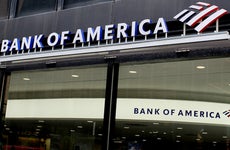Major U.S. bank mergers and acquisitions

The Bankrate promise
At Bankrate we strive to help you make smarter financial decisions. While we adhere to strict , this post may contain references to products from our partners. Here's an explanation for .
Mergers and acquisitions are a driving force in the world of finance. Banks, for example, are consolidating all the time, and mergers are how some of the largest banks in America have grown so large.
The U.S. Securities and Exchange Commission (SEC) defines a merger as what happens when two or more companies join into a single entity. Typically, a merger must be approved by the majority of shareholders of the company being acquired. In some cases, such as when the value is well into the billions of dollars, the majority of shareholders of the acquiring company require a vote of yes.
And some of the more recent bank mergers are among the biggest in the U.S. On Feb. 19, Capital One announced that it’s acquiring Discover Financial Services for $35.3 billion which, if approved, would make it the fifth largest U.S. bank. As of last December, Capital One is listed as the ninth largest U.S. bank, with consolidated assets of $475.6 billion, while Discover Bank is ranked at 27 with assets of $149.4 billion, according to the Federal Reserve.
Let’s look at some of the largest bank mergers and acquisitions, including some recent ones, and explore how mergers like these could affect you as a bank customer.
The largest bank mergers and acquisitions over the years
| Date | Acquiring bank | Acquired bank | Purchase price |
|---|---|---|---|
| *Date proposed merger was announced. This list represents, to the best of our knowledge, the largest bank mergers based on purchase price. | |||
| Sept. 30, 1998 | Bank of America | NationsBank | $62 billion |
| July 1, 2004 | J.P. Morgan Chase | Bank One | $58 billion |
| Jan. 1, 2009 | Bank of America | Merrill Lynch | $50 billion |
| Oct. 27, 2003 | Bank of America | Fleet | $47 billion |
| Feb. 19, 2024* | Capital One | Discover Bank | $35.3 billion |
| July 2, 2007 | Bank of New York | Mellon Financial Corp. | $18.4 billion |
| Oct. 3, 2008 | Wells Fargo | Wachovia Corp. | $15.1 billion |
| Aug. 28, 1995 | Chase Manhattan Corp. | Chemical Banking Corp. | $10 billion |
| Dec. 31, 2008 | PNC | National City | $6.1 billion |
| June 23, 2017 | CIBC | PrivateBancorp | $5 billion |
| July 29, 2016 | KeyCorp | First Niagara | $4.1 billion |
Recent bank mergers and acquisitions
| Date | Acquiring bank | Acquired bank | Purchase price |
|---|---|---|---|
| Feb. 1, 2023 | BMO Harris | Bank of the West | $16.3 billion |
| April 2, 2022 | M&T Bank | People’s United | $8.3 billion |
| Jan. 4, 2022 | First Citizens | CIT Bank | $2.2 billion |
| June 9, 2021 | Huntington | TCF | $6 billion |
| Dec. 9, 2019 | BB&T and SunTrust (merger of equals) | $66 billion | |
Bank failures can lead to acquisitions
In 2023, Silicon Valley Bank, Signature Bank and First Republic all failed as a result of customers pulling out their deposits – what is known as a run on the bank. All three have new owners. Silicon Valley Bank depositors are now with First Citizens, while Signature Bank customers are with Flagstar Bank, a subsidiary of New York Community Bancorp, and First Republic customers now bank with Chase.
Chase received around $92 billion worth of deposits when it acquired “the substantial majority of assets and assumed the deposits and other liabilities of First Republic,” according to a Chase press release.
How bank mergers and acquisitions affect you
Your bank could merge with a bank, acquire another bank or be acquired by another bank. Sometimes the largest banks become even larger through these deals. Or a bank failure could cause consolidation.
These deals can affect consumers, who might need to change the way they bank. Changes could include:
- Branch closures
- New checks
- New account numbers
- New routing numbers
- New account products
Bottom line
The number of banks insured by the Federal Deposit Insurance Corp. has decreased nearly 27 percent from March 31, 2015, to Dec. 31, 2022. And that trend is likely to continue due to consolidation and the lack of new banks.
Banking tends to be a long-term relationship. A Bankrate survey published in 2023 found that the average checking account holder in the U.S. has been with their bank or credit union for 17 years. So it’s possible that you’ll experience a banking merger or consolidation at some point, even if you never make a move to switch banks.
Related Articles



